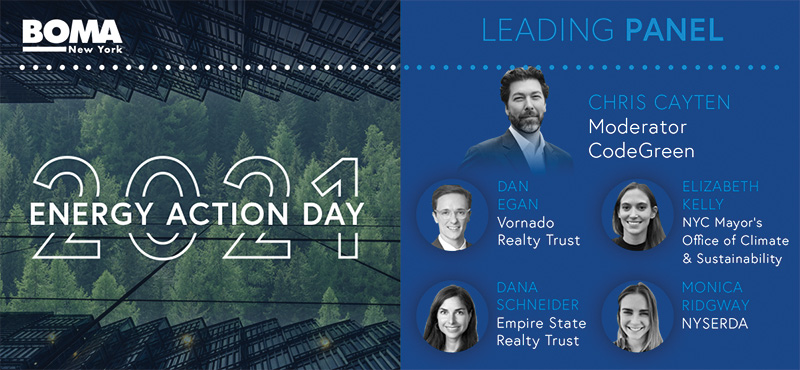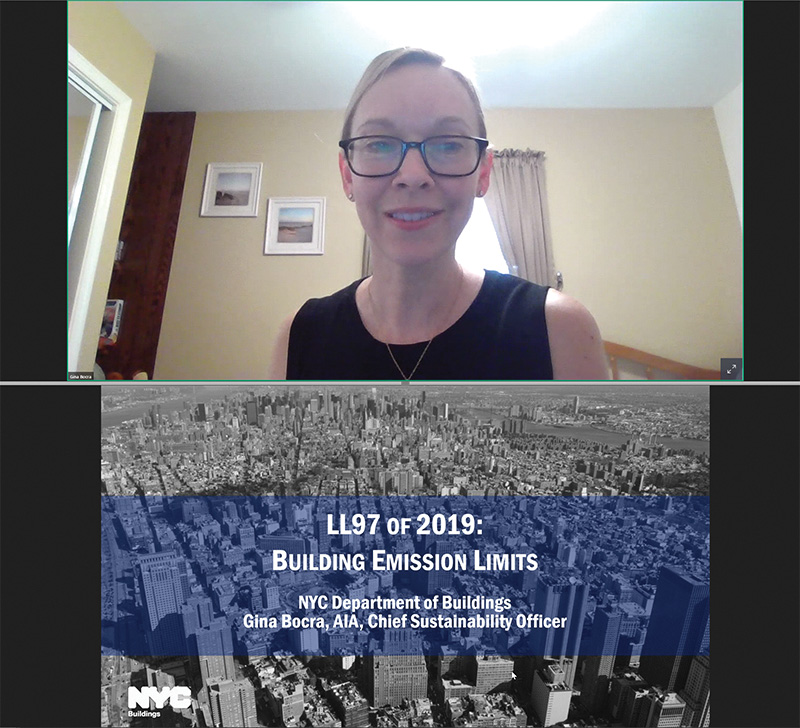
New York, NY As property managers and building owners rise to meet the emission goals mandated by Local Law 97, they are learning how to measure energy efficiency savings–not only in dollars, but in amounts of carbon reduction.
 BOMA New York’s Energy Action Day event for 2021 boasted a virtual full-house audience on June 29th, with a keynote address by Gina Bocra, AIA, the city’s foremost authority on efforts to reduce emissions from buildings. Her keynote address was followed by an informative, up-to-the-minute panel discussion by real estate industry and government experts on where we are with implementing Local Law 97, which requires major reductions in greenhouse gas emissions from NYC buildings starting in 2024.
BOMA New York’s Energy Action Day event for 2021 boasted a virtual full-house audience on June 29th, with a keynote address by Gina Bocra, AIA, the city’s foremost authority on efforts to reduce emissions from buildings. Her keynote address was followed by an informative, up-to-the-minute panel discussion by real estate industry and government experts on where we are with implementing Local Law 97, which requires major reductions in greenhouse gas emissions from NYC buildings starting in 2024.
As the Department of Building’s chief sustainability officer and chairperson of the city’s LL97 Advisory Board, which is tasked with working out critical technical details of implementing the carbon reduction law, Bocra offered detailed information regarding LL97 implementation and compliance.
She opened with a rundown of the NYC Climate Mobilization Act of 2019, which, in addition to LL97, includes LL95, which upgrades energy efficiency grading and mandates new signage in building lobbies to inform the public of a building’s energy conservation score. Bocra also touched upon LL96, which inaugurates the City’s sustainable energy loan program, known as PACE; as well as LL92 and LL94, earlier measures that require new buildings to have green roof covering or solar photovoltaic panels. In just one sentence, she summed up the new paradigm for owners and managers, “We are moving from measuring reduction in costs to reduction in carbon.”
She urged owners to start making improvements now that, under LL97, must be benchmarked for 2024, with mandatory, building-by-building carbon reduction progress reports due on May 1, 2025, followed by annual reporting. The goal is “40 by 30,” or the achievement of a 40% reduction in carbon emissions by 2030.
She noted that changes in the electrical supply grid will have a significant impact on owners’ reduction efforts, but the predicted effects of those changes were still under study by the Advisory Board. Bocra also reported that the city is studying a “carbon trading scheme,” but it was too early to announce a plan.
About fines and penalties, Bocra reported that each property will be assigned a Greenhouse Gas (GHG) budget, based on occupancy. The penalty for exceeding that budget, or having excess emissions, will be $268 per metric ton of CO2. She added, however, “We’re not interested in collecting fines. We’re interested in cutting emissions.”
In closing, Bocra offered advice to owners who are just starting. She urged owners to review the city’s published list of prescriptive measures, beginning with adjusting set points for heat and hot water. “Review your energy benchmarking history,” she said. “Use the New York City Deep Energy Retrofit Analysis Planning Tool (DERPA) and contact the New York City Accelerator for assistance.”
The panel was moderated by BOMA NY’s Energy & Sustainability Committee Chair Chris Cayten of CodeGreen Solutions, an industry expert in sustainability in commercial real estate. The panel included two owner experts in building emissions reductions and the technical aspects of LL97 compliance: Dan Egan, senior vice president for sustainability and utilities, Vornado Realty Trust, and Dana Schneider, senior vice president, director of energy, sustainability and ESG for Empire State Realty Trust. The other two panelists, Monica Ridgway from NYSERDA and Elizabeth Kelly from the NYC Mayor’s Office of Climate & Sustainability, focused on incentives and other tools for helping buildings meet emissions mandates.
Cayten opened the discussion by reporting that owners’ present awareness of LL97 ranged from “denial to preparation.” He echoed Bocra’s advice to start with the city’s prescriptive list of action items. Bocra retorted in acknowledgment that carbon reduction “is an enormous challenge,” saying, “There will be changes in Local Law 87 that will make it easier to comply with Local Law 97. There are savings that are there. We have to see how we can reduce loads in each building.”
Schneider, whose entire career is centered on “sustainability in the built environment,” took a global view. She said, “Local Law 97 is a great step on a global leadership scale. We will see what will work and what might not work. This will set a model for the rest of the world.” She referenced the Empire State Building–the jewel in her firm’s crown–which just turned 90 years of age. “We reduced emissions by 54% since 2007 at the Empire State Building.”
Egan said that Vornado’s decade-long energy sustainability policy “covers every part of our business,” and that it was his firm’s goal to “demonstrate a carbon neutral portfolio by 2030.” Both Schneider and Egan noted that office workers are flocking back to the city and that their occupancy rates were about 20%, post COVID-19.
Kelly reminded attendees that 68% of NYC’s carbon emissions come from buildings, and that 90% of the city’s buildings will be here in 2050. She encouraged owners to take advantage of the NYC Accelerator, which offers no cost training and support, free technical guidance, and green workforce development programs. She said, “There’s no catch, no cost and no sign-up fee.” She also cited the City’s Commercial Property Assessed Clean Energy Finance program, new for 2021. The program launched and just closed its first loan for more than $80 million.
Ridgway of NYSERDA listed several new incentive programs offered by New York State. Its Commercial and Industrial Carbon Challenge has $15 million available for “high-impact users” of electricity to fund the execution of carbon reduction projects. Deadline to apply for the Challenge is July 30th. Likewise, the State’s Carbon Neutral Economic Development Program has $15 million allocated as incentives to users who can operate at a carbon neutral or net-zero energy consumption.
Ridgway highlighted the State’s Empire Building Challenge, a $50 million initiative to demonstrate the efficiency and cost savings associated with low-carbon retrofits. The program, centered on high-rise buildings and large portfolio owners, has enrolled properties comprising 31 million SF so far. “Partners in the program include Empire State Realty Trust, Vornado, Durst, Jonathan Rose Companies, Silverstein, Rudin, Omni New York, LLC; LM Development Partners, Hudson Square Properties, and Beam Living.”
Cayten applauded the City and State for their “huge push to incentivize owners.” He likened the movement toward carbon neutrality as “having to learn a whole new industry.” He said that learning to measure savings not in costs, but in carbon reduction was “throwing the industry for a loop,” but in a good way.
In conclusion, Cayten asked the panelists whether the COVID-19 pandemic had “helped or hindered,” their carbon reduction efforts.
Egan commented that during the pandemic he observed an “inelastic relationship between energy consumption and occupancy,” noting a 30% energy reduction when compared to pre-pandemic levels. He said that office tenants maintained a “fixed base energy level” while supporting people working from home. He observed that tenants’ servers, desktop computers and even their office copying machines remained on “even though there were no occupants.”
Despite this observation, Vornado was able to engage meaningfully with tenants on energy conservation. Egan added, “facility managers were able to enter their spaces to shut some things down and save money on their submetering bill.” Virtual tenant roundtables and weekly energy consumption reports helped keep tenants aware of the relationship between their office energy usage and carbon emissions.
Schneider said, “We’re figuring out what comes next. First, we are making tenants aware of the steps we are taking to keep them safe.” The new reality, she said, will be “efficiency and health.”
She, like Egan, was proud that her firm’s buildings remained open “through it all,” but was not too happy about, “Our occupancy is up to 20%, but our energy bill isn’t down 80%.” She said, “One of our biggest opportunities is just to turn things off when they’re not needed. We saw monitors turned on when tenants weren’t in the space for months.”
On an optimistic note, Ridgway observed “a huge uptick in our energy management incentive programs during the pandemic.”
Cayten concluded: “The thing that COVID taught us is that we don’t know what the future will bring in terms of varied occupancy.” The consensus was to “look at your energy benchmarks and realize that your building is an ecosystem. Look at all your systems, and the people in your buildings.”
